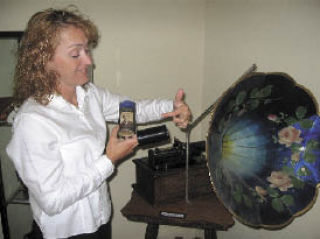Exhibit is more than rabbit ears
Did you know Thomas Edison’s cylinder phonograph could be used to play and record sound? And that magnetic tape-recording technology was actually taken from the Germans after World War II?
From the early days of the phonograph and film to modern-day CDs and DVDs, media have come a long way in the last century. And now Kent residents can take a tour through that history thanks to a new Kent Historical Museum exhibit, entitled “20th Century Technology: 100 Years of Multi-media.”
“It shows us how far we’ve come,” Wagner said, standing among the years of history in an upstairs room of the museum.
The exhibit, which is on display until Aug. 29, includes many types of audio and video recorders and players, all situated around the room according to their place in the multi-media timeline. An extensive timeline is posted on the walls with each featured device’s date of invention as well as the dates of other important media developments in history.
One of the earliest pieces in the exhibit is a large phonograph from the late 1800s, a device invented by Thomas Edison in 1877 that uses wax cylinders to record and play back music. The removable cylinder’s cardboard box bears its inventor’s face.
“Most people don’t know that this machine could record as well as play back sound,” Wagner said, holding up the cylinder.
The cylinder was eventually replaced by the record in the early 1900s, and the phonograph was later replaced by the record player. A collection of old records and an early portable player is part of the Kent exhibit.
“When they first started making records, they only had one side,” Wagner said. “The other side was blank. It wasn’t until 1908 that they started producing two-sided records.”
Another piece featured at the museum is a small, saxophone-shaped device, called the “QRS Playsax and Roll.” The early 1900s device was like a miniature version of the player piano. The user blows into the sax while turning a handle to play a pre-determined song.
Wagner said she was particularly fascinated by an early radio on display. Called a crystal radio, the device received and played broadcasted signals and was made up only of antenna wire, a coil of copper wire, a crystal detector and earphones.
The exhibit continues through the 20th century with an early-console TV, a reel-to-reel recorder and an old 8-millimeter film projector set up to play vintage films for museum patrons. It also features more modern pieces, like the 1970s-spawned Laserdisc player, the predecessor to the DVD player.
The historical timeline reveals interesting facts about each piece, such as how magnetic tape-recording technology found in cassette tapes was taken from the Germans during World War II and how the first remote control, dubbed the “Lazy Boy,” was connected to the TV by a long wire.
Wagner said the exhibit makes you appreciate the technology we have today.
“It used to be that everything was just powered by human energy, but that’s all changed,” she said. “As you walk through the exhibit, you can really see how it has evolved.”
Many of the exhibit’s items are on loan from local collector Jack Becvar, and some of them were donated to the museum over the years, Wagner said. The exhibit will be on display until Aug. 29.
In September, the museum will begin a new exhibit featuring the artwork of Northwest native Kenjuro Nomur, one of the approximately 110,000 Japanese Americans and Japanese nationals interned in the U.S. during World War II.
Learn more
What: New Kent Historical Museum exhibit featuring 100 years of multi-media devices
Where: Kent Historical Museum, 855 E. Smith St., Kent
When: Noon-4 p.m. Wednesday-Saturday until Aug. 29
Cost: By donation
Information: 253-854-4330 or www.kenthistoricalmuseum.org
Talk to us
Please share your story tips by emailing editor@kentreporter.com.
To share your opinion for publication, submit a letter through our website https://www.kentreporter.com/submit-letter/. Include your name, address and daytime phone number. (We’ll only publish your name and hometown.) Please keep letters to 300 words or less.

